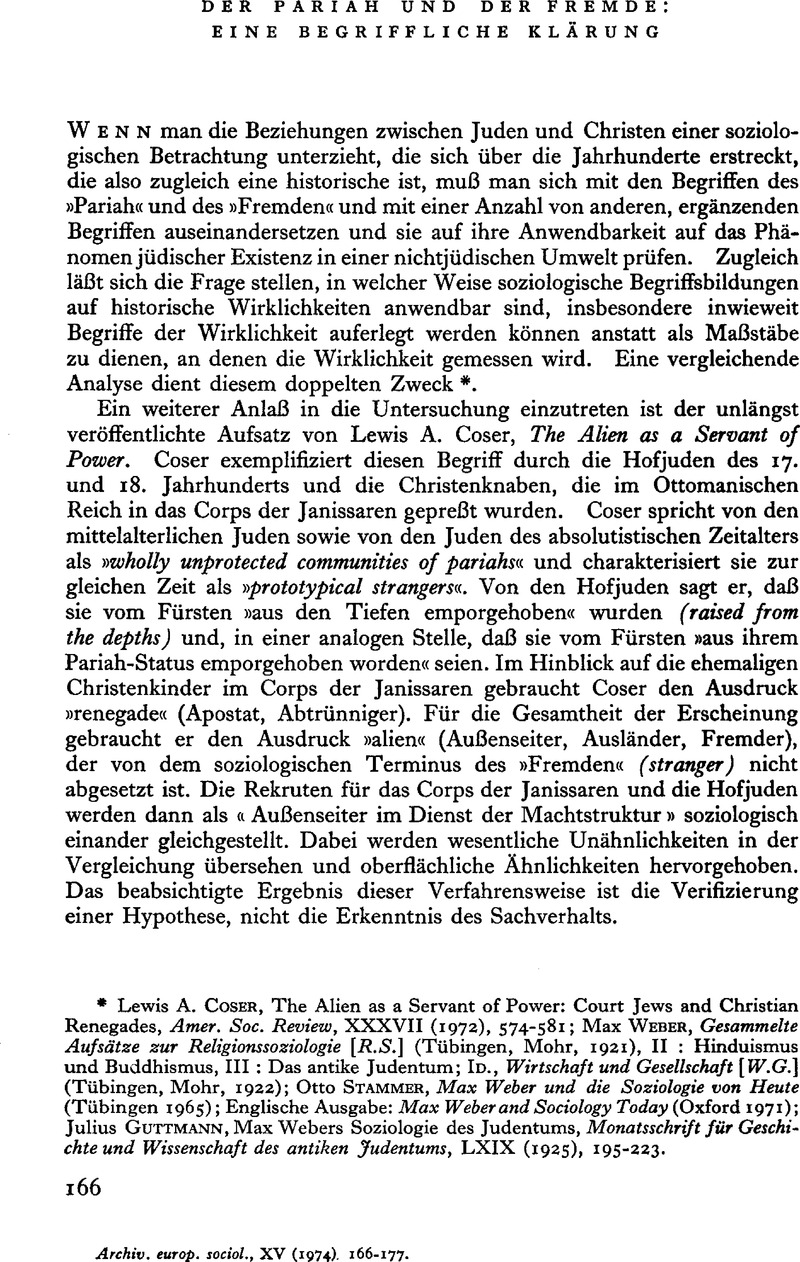Article contents
Der Pariah und der Fremde: eine begriffliche Klärung
Published online by Cambridge University Press: 28 July 2009
Abstract

- Type
- Notes Critiques
- Information
- European Journal of Sociology / Archives Européennes de Sociologie , Volume 15 , Issue 1 , May 1974 , pp. 166 - 177
- Copyright
- Copyright © Archives Européenes de Sociology 1974
References
* Coser, Lewis A., The Alien as a Servant of Power: Court Jews and Christian Renegades, Amer. Soc. Review, XXXVII (1972), 574–581CrossRefGoogle Scholar; Weber, Max, Gesammelte Aufsätze zur Religionssoziologie [R.S.] (Tübingen, Mohr, 1921), IIGoogle Scholar: Hinduismus und Buddhismus, III: Das antike Judentum; Id., Wirtschaft und Gesellschaft [W.G.] (Tübingen, Mohr, 1922); Stammer, Otto, Max Weber und die Soziologie von Heute (Tübingen 1965)Google Scholar; Ausgabe, Englische: Max Weber and Sociology Today (Oxford 1971)Google Scholar; Guttmann, Julius, Max Webers Soziologie des Judentums, Monatsschrift für Geschichte und Wissenschaft des antiken fudentums, LXIX (1925), 195–223Google Scholar.
(1) Sigrist, Christian in Stammer, Otto, Max Weber and Sociology Today (a.a.O.), pp. 240 ffGoogle Scholar; in der deutschen Ausgabe, die mir gegenwärtig nicht zur Hand ist, S. 326 (mit Bezug auf die Heidelberger Tagung der Deutschen Gesellschaft für Soziologie).
(2) Stammer, Otto, a.a.O., S. 197Google Scholar. Daß Parsons sich hier selbst widerspricht, ist eine andere Sache. Er meint, daß nicht hoher oder niederer Rang, sondern »rituelle Ausschließung« der entscheidende Punkt sei, gibt aber zu, daß die Juden, anders als die Pariahs, nicht ausgeschlossen worden seien, sondern sich selbst ausgeschlossen hätten. Wo bleibt da der » gültige Vergleich « ? Auf diese Selbstbestimmtheit der Juden bezieht sich Joseph Maier (S. 193) unter Hinweis auf Salo Baron, W., A Social and Religious History of the Fews, Vol. III (New York 1937), S. 5Google Scholar, um das genaue Gegenteil dessen, was Parsons behauptet, zu erhärten, nämlich, daß der Vergleich Juden-Pariahs unzulässig ist.
(3) Hempel, Carl G., Problems of Concept and Theory Formation in the Social Sciences, in Science, Language and Human Rights (Philadelphia 1952), S. 71 fGoogle Scholar.
(4) Dubois, J. A. and Beauchamp, Henry K., Hindu Manners, Customs and Ceremonies (Oxford 1897), pp. 51–69Google Scholar; Fuchs, Stephan, The Children of Hart (Vienna 1950)Google Scholar; Thurston, Edgar and Rangachari, K., Castes and Tribes of Southern India, Vol. VI (Madras 1909), pp. 79–139Google Scholar.
(5) Cahnman, Werner J., Religion and Nationality in Cahnman, W. J. and Boskoff, A., Sociology and History: theory and research (New York, Free Press, 1964), pp. 271–280Google Scholar und die dort zitierte Literatur.
(6) Ein weiterer Hinweis auf die Identifizierung von Religion und Volkstum im Begriff des Millet findet sich in Tsakonas, Demetrius, Geist und Gesellschaft im Neuen Griechenland (Bonn 1968), S. 18Google Scholar.
(7) Gumplowicz, Ludwig, Der Rassen kampf (Innsbruck 1883), S. 211 fGoogle Scholar.; Brentano, Lujo, Der wirtschaftende Mensch in der Geschichte (Leipzig 1923), Ss. 21, 214–15, 369Google Scholaret passim; Tönnies, Ferdinand, Das Individuum und die Welt in der Neuzeit, in Fortschritt und soziale Entwicklung (Karlsruhe 1926), Ss. 5–35Google Scholar; Gemeinschaft und Gesellschaft (Darmstadt 1970; 1. Aufl. 1887), Ss. 27, 57 f., 166 f.Google Scholar; Simmel, Georg, Exkurs über den Fremden, in Soziologie (Leipzig 1908), Ss. 685–91Google Scholar. Tönnies beruft sich (S. 167) auf SirMaine, Henry, Village Communities in East and West (London 1871), S. 126Google Scholar.
(8) Tönnies, a. a.O., S. 57.
(9) Ich gebrauche den Ausdruck »Vermittler« in einem noch nicht veröffentlichten Buch, fews and Gentiles: a historical sociology of their relations.
(10) Mommsen, Theodor, Römische Geshichte, Vol. V, Kap. XI: «Judaea und die Juden» (Berlin 1885)Google Scholar.
(11) Vgl. Taubes, Jakobin Stammer, , a. a.O., p. 188Google Scholar.
(12) Julius Guttmann op. laud.
(13) Zuckerman, Arthur J., The Political Uses of Theology: the conflict of Bishop Agobard and the Jews of Lyon, in Western Michigan University Studies of Medievalc Culture, III (1970), pp. 23–51Google Scholar.
(14) Park, Robert E., Migration, Human and the Man, Marginal, Amer. Journ. of Sociology, XXXIII (1928), 881–893CrossRefGoogle Scholar; Bbcker, Howard, Through Values to Social Interpretation (Durham, N. C, 1950), pp. 113–109Google Scholar.
(15) Coser, a. a. O.
(16) Stern, Selma, Der preußische Staat und die Juden, Teil I (Tubingen 1962), Ss. 149–50Google Scholar.
(17) Stern, Selma, The Court few (Philadelphia 1950), Ss. 19 f., 25 fGoogle Scholar.; Wald, M. Grune, Samuel Oppenheimer und sein Kreis: ein Kapitel aus der Finanzgeschichte Oesterreichs (Wien/Leipzig 1913)Google Scholar.
(18) Szajkowski, Zosa, Jews and the French Revolutions of 1789, 1830 and 1848 (New York 1970), S. 298 fGoogle Scholar.; Ger, M. Ginsbur, Cerfberr et son époque (Guebwiller 1908)Google Scholar.
(19) Dohm, Christian Wilhelm, Über die bürgerliche Verbesserung der Juden (Berlin/Stettin, 1. Aufl. 1781)Google Scholar.
(20) Arendt, Hannah, The Origins of Totalitarianism (London 1951), p. 14Google Scholar.
(21) Stern, Selma, The Court Few, a. a. O., S. 205 f.Google Scholar; Id.Der Preußische Staat, a. a. O., S. 256 f.
(22) Stern, Selma, The Court few, a. a. O., S. 256 fGoogle Scholar.
(23) Feilchenfeld, A. (ed.) Die Denkwürdigkeiten der Glückel von Hameln, (Berlin 1913). Ss. 117–122Google Scholar.
(24) Weber, Max, Wirtschaftsgeschichte (München/Leipzig 1924), S. 306 fGoogle Scholar.
(25) Hümmert, L., Die finanziellen Beziehungen jüdischer Bankiers und Heereslieferanten zum bayerischen Stoat (München 1927), S. 40Google Scholar.
(26) Arendt, Hannah, a. a. O., Ss. 56–68Google Scholar.
(27) Arendt, Hannah, a. a. O., S. 64Google Scholar; die Stelle ist aus Boerne's, L.Briefe aus Paris, 74Google Scholar. Brief, Febr. 1832 entnommen.
(28) Cahnman, Werner J., The Frustrated Escapist, The Reconstructionist, XXIV (1958), 15–20Google Scholar.
* Mit Anmerkungen versehener Text eines Referats vor dem soziologischen Seminar der Universität Tübingen am 5. Juli 1973.
- 3
- Cited by


